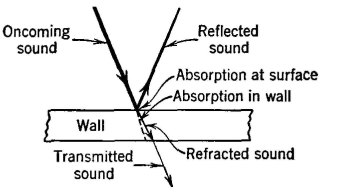| Electrical Communication is a free textbook on the basics of communication technology. See the editorial for more information.... |

|

Home  Fundamentals of Acoustics Fundamentals of Acoustics  The Transmission of Sound The Transmission of Sound |
|||






|
|||
The Transmission of SoundThe sound energy that reaches and actuates the ear, a telephone transmitter, or a radio microphone is usually transferred from the vibrating source through the intervening air. There is, therefore, a certain (small) amount of energy in the air in the form of sound waves at any instant. If a sound source is in the open and continues to vibrate, energy is continually emitted by it. The sound waves travel outward until this energy is spread out and dissipated; then the sound becomes inaudible. Some of the energy is dissipated by heating the air. If, however, the waves in traveling from the source strike an obstruction in their path such as an ordinary wall, most of the sound energy is reflected. When the sound waves generated in a room strike the rigid plastered walls, about 95 per cent of the sound energy will be reflected back into the room. If the wall is massive and not set vibrating as a whole, part of the energy which is not reflected is absorbed by the surface layers of the wall. The portion not reflected or absorbed is transmitted as a very feeble wave motion in the material of the wall itself. These phenomena are shown in Fig. 1. If the source of sound is in air and not in rigid mechanical contact with the walls or floor of a room and if the walls are massive so that they will not be set in flexural vibration by the sound waves, then very little sound energy will be transmitted to other rooms in the building. If the vibrating body is in rigid contact with the walls or floor of the room, then vibrations will readily be transmitted to all parts of the building. These vibrations then will set up sound waves in the air in the adjoining rooms.
When sound waves originate in air, they are transmitted through an obstructing medium such as a partition in three ways. First, sound may pass through the air spaces of a porous material. Second, the sound waves in the air may produce corresponding condensations and rarefactions in the material of the obstruction. This wave, which is very feeble, then proceeds through the material and produces sound waves in the air on the opposite side. Third, sound energy may be transmitted by setting the obstruction as a whole in motion. The vibrating obstruction then sets up sound waves on the opposite side. Sound absorption at the surface of a material is caused by the friction which occurs between vibrating air particles and the walls of the interstices in the surface of the absorbing material. The friction converts the wave energy into heat energy. If a wall or partition is caused to vibrate by sound waves, then internal friction between the fibers of the material will absorb sound energy. The transmission of sound through absorbing material varies according to the equation
where i represents the sound intensity transmitted, i0 the sound intensity which is impressed, a is a constant depending on the type of material, and x is the thickness of the material. Measurements of the sound intensity sometimes are made with the Rayleigh disk resonator,1,3 but more often with a calibrated microphone.
|
|||
Home  Fundamentals of Acoustics Fundamentals of Acoustics  The Transmission of Sound The Transmission of Sound |
|||
Last Update: 2011-05-30



